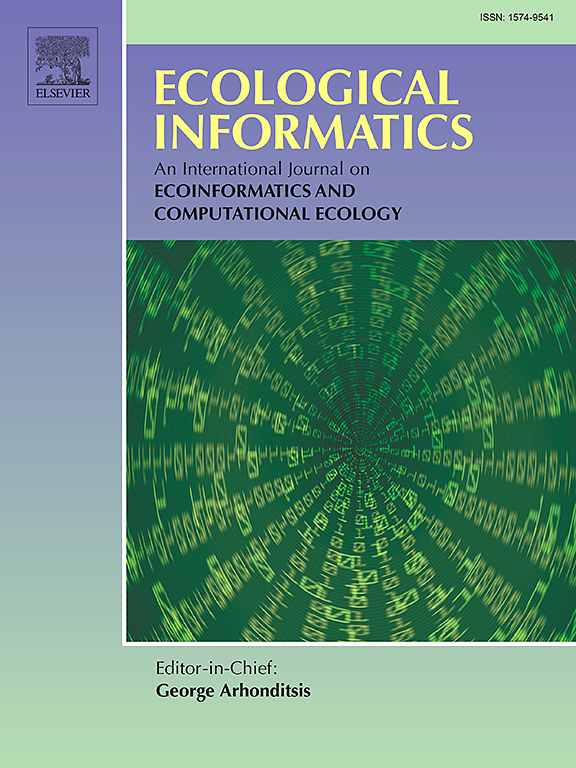量化多尺度动物运动模型不确定性的高效近似贝叶斯推理
IF 5.8
2区 环境科学与生态学
Q1 ECOLOGY
引用次数: 0
摘要
对于野生动物管理者和保护生态学家来说,了解动物选择或避开哪些资源以及如何最好地预测动物种群未来的长期空间分布变得越来越重要。然而,推断动物的空间利用模式是一个具有挑战性的多尺度推断问题,而参数估计的正式不确定性量化是跨尺度提供有用预测的模型的重要组成部分。在本研究中,我们为动物运动的阶跃选择模型开发了一个近似贝叶斯推断框架,在贝叶斯范式中量化了资源选择和回避参数估计的不确定性。该框架允许对动物的运动和资源选择参数进行联合推断,并且是多尺度的,因为从精细尺度的运动步长中推断出的参数可以对空间利用的长期模式进行预测。我们的分析侧重于模拟运动数据,通过改变数据生成过程中的运动参数来测试框架的性能。在我们的模拟中,个体对两个环境协变量做出反应,我们采用了正选择系数和负选择系数的所有组合,分别对应于吸引环境特征和回避环境特征。在所有情况下,我们都使用变异推理(一种近似贝叶斯方法)来恢复用于模拟合成运动数据的运动参数,这使我们能够正式量化与不同数据集大小的每个参数相关的不确定性。值得注意的是,我们的分析表明,即使对于相当大的数据集(约 10,000 个观测值),资源选择参数仍可能存在相当大的不确定性,如果不适当地将其纳入建模方法,这些不确定性反过来又会导致对长期空间利用的不准确预测。为了进一步说明我们的方法的实用性,我们还介绍了一个案例研究,将其应用于由渔夫(Martes pennanti)的 GPS 位置组成的示例数据集。我们的方法将引起生态学家的兴趣,他们希望解决保护问题,如动物可能在何时何地度过其大部分时间。此外,这种方法还可用于根据 GPS 定位动物如何使用或避开资源来预测新的合适保护区域,同时将预测的不确定性包括在内,从而帮助做出明智的管理决策。本文章由计算机程序翻译,如有差异,请以英文原文为准。
Efficient approximate Bayesian inference for quantifying uncertainty in multiscale animal movement models
It is becoming increasingly important for wildlife managers and conservation ecologists to understand which resources are selected or avoided by an animal and how to best predict future spatial distributions of animal populations in the long term. However, inferring the patterns of space use by animals is a challenging multiscale inference problem, and formal uncertainty quantification of parameter estimates is an essential component of models that provide useful predictions across scales. In this study, we develop an approximate Bayesian inference framework for step selection models of animal movement which quantifies the uncertainty in estimates of resource selection and avoidance parameters within the Bayesian paradigm. The framework allows joint inference of movement and resource selection parameters of animals and is multiscale in that parameters inferred from fine scale movement steps scale to produce predictions of long-term patterns of space use. Our analysis focuses on simulated movement data in which we test the performance of our framework by altering movement parameters in the data-generating process. In our simulations, individuals respond to two environmental covariates and we employ all combinations of positive and negative selection coefficients corresponding to attraction to an environmental feature and avoidance of an environmental feature, respectively. In all scenarios, we recover the movement parameters used for the simulation of synthetic movement data using variational inference, an approximate Bayesian method, allowing us to formally quantify the uncertainty associated with each parameter for varying data set sizes. Our framework successfully recovered all combinations of movement parameters of the simulated data and accurately captured their posterior distributions given the available data suggesting that the framework is reliable and suitable for inferring how animals select resources and move on a landscape.
Notably, our analysis shows that even for reasonably large data sets (circa 10,000 observations) there can still be considerable uncertainty associated with resource selection parameters which can in turn lead to inaccurate predictions of long term space use if not properly incorporated into the modelling approach. To further illustrate the utility of our approach, we also present a case study of its application to an example data set consisting of GPS locations of a fisher (Martes pennanti). Our approach will be of interest to ecologists looking to address conservation questions such as when and where animals are likely to spend most of their time. Furthermore, the approach could be used to predict new suitable areas for conservation based on how GPS collared animals use or avoid resources while including uncertainty around the predictions, thereby helping to make informed management decisions.
求助全文
通过发布文献求助,成功后即可免费获取论文全文。
去求助
来源期刊

Ecological Informatics
环境科学-生态学
CiteScore
8.30
自引率
11.80%
发文量
346
审稿时长
46 days
期刊介绍:
The journal Ecological Informatics is devoted to the publication of high quality, peer-reviewed articles on all aspects of computational ecology, data science and biogeography. The scope of the journal takes into account the data-intensive nature of ecology, the growing capacity of information technology to access, harness and leverage complex data as well as the critical need for informing sustainable management in view of global environmental and climate change.
The nature of the journal is interdisciplinary at the crossover between ecology and informatics. It focuses on novel concepts and techniques for image- and genome-based monitoring and interpretation, sensor- and multimedia-based data acquisition, internet-based data archiving and sharing, data assimilation, modelling and prediction of ecological data.
 求助内容:
求助内容: 应助结果提醒方式:
应助结果提醒方式:


